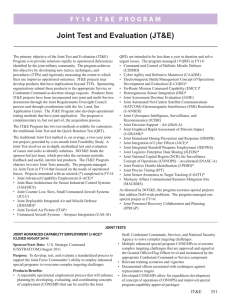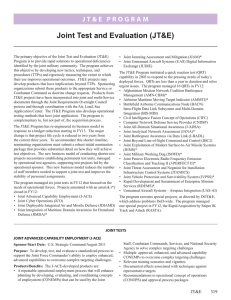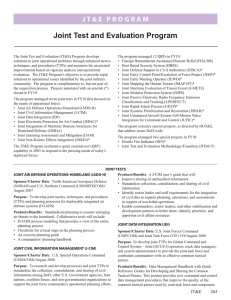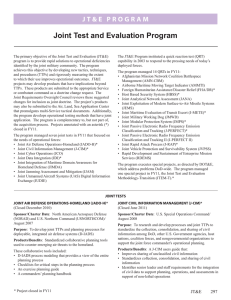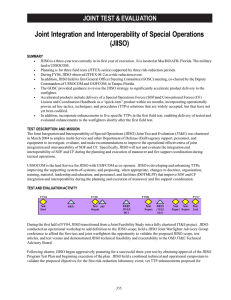Joint Test and Evaluation (JT&E)
advertisement
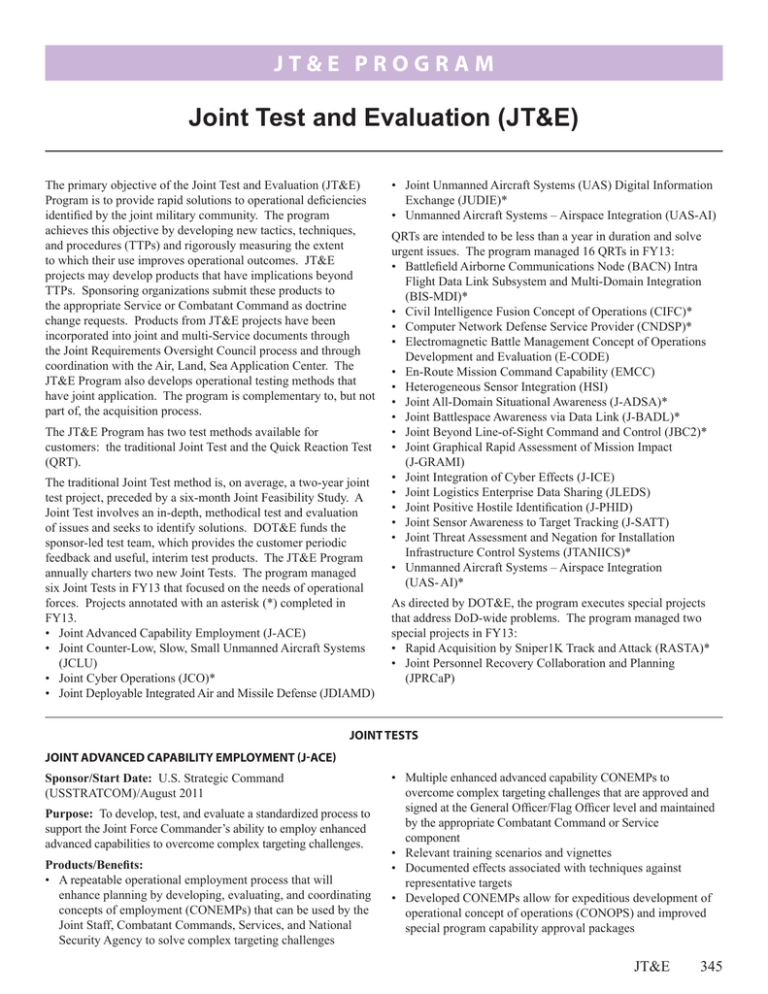
JT&E Program Joint Test and Evaluation (JT&E) The primary objective of the Joint Test and Evaluation (JT&E) Program is to provide rapid solutions to operational deficiencies identified by the joint military community. The program achieves this objective by developing new tactics, techniques, and procedures (TTPs) and rigorously measuring the extent to which their use improves operational outcomes. JT&E projects may develop products that have implications beyond TTPs. Sponsoring organizations submit these products to the appropriate Service or Combatant Command as doctrine change requests. Products from JT&E projects have been incorporated into joint and multi-Service documents through the Joint Requirements Oversight Council process and through coordination with the Air, Land, Sea Application Center. The JT&E Program also develops operational testing methods that have joint application. The program is complementary to, but not part of, the acquisition process. The JT&E Program has two test methods available for customers: the traditional Joint Test and the Quick Reaction Test (QRT). The traditional Joint Test method is, on average, a two-year joint test project, preceded by a six-month Joint Feasibility Study. A Joint Test involves an in-depth, methodical test and evaluation of issues and seeks to identify solutions. DOT&E funds the sponsor-led test team, which provides the customer periodic feedback and useful, interim test products. The JT&E Program annually charters two new Joint Tests. The program managed six Joint Tests in FY13 that focused on the needs of operational forces. Projects annotated with an asterisk (*) completed in FY13. • Joint Advanced Capability Employment (J-ACE) • Joint Counter-Low, Slow, Small Unmanned Aircraft Systems (JCLU) • Joint Cyber Operations (JCO)* • Joint Deployable Integrated Air and Missile Defense (JDIAMD) • Joint Unmanned Aircraft Systems (UAS) Digital Information Exchange (JUDIE)* • Unmanned Aircraft Systems – Airspace Integration (UAS-AI) QRTs are intended to be less than a year in duration and solve urgent issues. The program managed 16 QRTs in FY13: • Battlefield Airborne Communications Node (BACN) Intra Flight Data Link Subsystem and Multi-Domain Integration (BIS-MDI)* • Civil Intelligence Fusion Concept of Operations (CIFC)* • Computer Network Defense Service Provider (CNDSP)* • Electromagnetic Battle Management Concept of Operations Development and Evaluation (E-CODE) • En-Route Mission Command Capability (EMCC) • Heterogeneous Sensor Integration (HSI) • Joint All-Domain Situational Awareness (J-ADSA)* • Joint Battlespace Awareness via Data Link (J-BADL)* • Joint Beyond Line-of-Sight Command and Control (JBC2)* • Joint Graphical Rapid Assessment of Mission Impact (J-GRAMI) • Joint Integration of Cyber Effects (J-ICE) • Joint Logistics Enterprise Data Sharing (JLEDS) • Joint Positive Hostile Identification (J-PHID) • Joint Sensor Awareness to Target Tracking (J-SATT) • Joint Threat Assessment and Negation for Installation Infrastructure Control Systems (JTANIICS)* • Unmanned Aircraft Systems – Airspace Integration (UAS- AI)* As directed by DOT&E, the program executes special projects that address DoD-wide problems. The program managed two special projects in FY13: • Rapid Acquisition by Sniper1K Track and Attack (RASTA)* • Joint Personnel Recovery Collaboration and Planning (JPRCaP) JOINT TESTS JOINT ADVANCED CAPABILITY EMPLOYMENT (J-ACE) Sponsor/Start Date: U.S. Strategic Command (USSTRATCOM)/August 2011 Purpose: To develop, test, and evaluate a standardized process to support the Joint Force Commander’s ability to employ enhanced advanced capabilities to overcome complex targeting challenges. Products/Benefits: • A repeatable operational employment process that will enhance planning by developing, evaluating, and coordinating concepts of employment (CONEMPs) that can be used by the Joint Staff, Combatant Commands, Services, and National Security Agency to solve complex targeting challenges • Multiple enhanced advanced capability CONEMPs to overcome complex targeting challenges that are approved and signed at the General Officer/Flag Officer level and maintained by the appropriate Combatant Command or Service component • Relevant training scenarios and vignettes • Documented effects associated with techniques against representative targets • Developed CONEMPs allow for expeditious development of operational concept of operations (CONOPS) and improved special program capability approval packages JT&E 345 JT&E Program JOINT COUNTER LOW, SLOW, SMALL UNMANNED AIRCRAFT SYSTEMS (JCLU) Purpose: To develop and test joint planning and execution processes and procedures for deployable IAMD for the homeland. Sponsor/Start Date: Air Force/August 2012 Products/Benefits: • IAMD process modeling that provides a comprehensive view of the integrated planning and execution process • NORAD and USNORTHCOM current operations planning processes, checklists, and procedures for IAMD • Continental NORAD Region, Alaska NORAD Region, and Air Forces North planning and execution TTPs for IAMD • Naval Forces North and Third Fleet planning and execution TTPs for naval support of IAMD • Army North planning and execution TTPs for operational control of ground-based IAMD forces • 263rd Army Air and Missile Defense Command planning and execution TTPs for IAMD Purpose: To develop, test, and evaluate integrated air and missile defense (IAMD) operator TTPs to increase operators’ ability to detect, track, and identify adversary low, slow, and small Unmanned Aircraft Systems (UAS) and provide timely notification to the Area Air Defense Commander. Products/Benefits: • TTPs to increase the operators’ ability to detect, track, and identify this UAS threat category • Integration of information from National Technical Means into a tactical datalink to support situational awareness and target identification • Development of the operational architecture and organizational relationships that will increase the cross-sharing of tactical information to increase the operators’ ability to execute the joint engagement sequence JOINT CYBER OPERATIONS (JCO)* (Closed January 2013) Sponsor/Start Date: U.S. Pacific Command (USPACOM)/August 2010 Purpose: To assess, develop, and evaluate joint TTPs to employ an adaptive cyber defense Virtual Secure Enclave strategy to enhance and ensure the protection and availability of critical command and control services. Products/Benefits: • Developed CONOPS, TTPs, and related training packages to provide the following capabilities-- Addressed network vulnerabilities of critical command and control services by enabling Joint Task Force Commanders to employ an adaptive cyber defense Virtual Secure Encalve to protect against, detect, and respond to cyber threats against specific command and control applications at the operational level - Provided the Commander with situational awareness and cyber defense options to maintain a proactive defensive posture - Facilitated a systematic approach to implement the principles of war in the cyber domain • Tested and validated operational effectiveness of joint task force implementation • Received CONOPS endorsement by the Joint Requirements Oversight Council for DoD-wide use JOINT DEPLOYABLE INTEGRATED AIR AND MISSILE DEFENSE (JDIAMD) Sponsor/Start Date: North American Aerospace Defense (NORAD), U.S. Northern Command (USNORTHCOM), Army Space and Missile Defense Command/August 2011 346 JT&E JOINT UNMANNED AIRCRAFT SYSTEMS (UAS) DIGITAL INFORMATION EXCHANGE (JUDIE) (Closed in September 2013) Sponsor/Start Date: Air Force/August 2010 Purpose: To develop, test, and evaluate cross-component UAS information exchange TTPs used to improve joint battlespace situational awareness and target prosecution capabilities for tactical commanders at the brigade level and below. Products/Benefits: • Standardized terminology for UAS information exchange • Recommended information portal and situational awareness display technology currently in use by the components to improve the efficiency of UAS information exchange • Introduced information exchange TTPs to combat training centers and formal training units • Provided comprehensive UAS Information Exchange TTPs and associated Quick Reference Guide • Integrated best practices and lessons learned into both joint and Service-specific TTPs UNMANNED AIRCRAFT SYSTEMS AIRSPACE INTEGRATION (UAS-AI) Sponsor/Start Date: NORAD, USNORTHCOM, and the Army Test and Evaluation Command/August 2012 Purpose: Standardize and evaluate procedures to effectively operate UAS in the National Airspace System (NAS). The UAS-AI Joint Test utilizes the product and builds upon the working relationships developed in the UAS-AI QRT. Products/Benefits: • Standardized procedures for predictably operating UAS in the NAS under routine, lost command link, lost two-way radio communications, and lost sense and avoid conditions • A common lexicon for UAS operations in the NAS • Partnership and collaboration with the Federal Aviation Administration to integrate UAS in the NAS by 2015 JT&E Program Quick Reaction Tests BATTLEFIELD AIRBORNE COMMUNICATIONS NODE (BACN) INTRA-FLIGHT DATALINK SUBSYSTEM AND MULTI-DOMAIN INTEGRATION (BIS-MDI)* (Closed February 2013) Sponsor/Start Date: USPACOM/November 2011 Purpose: To develop and evaluate TTPs for the BIS-MDI capability, an upgrade to the basic BACN system, to provide interoperability across multi-band voice and datalink communications in order to bridge widely separated Link 16 networks. This will greatly enhance situational awareness, information sharing, and operational effectiveness, especially between fourth- and fifth-generation fighter aircraft and surface shooters. Products/Benefits: • Fusion of sensor information from multiple sources, including fourth- and fifth-generation platforms, to enhance the operator’s common operational picture • Joint and coalition operator CONOPS and TTPs to employ the BIS-MDI capability in support of potential combat support operations conducted in an anti-access and area-denial environment in the USPACOM theater CIVIL INTELLIGENCE FUSION CONCEPT OF OPERATIONS (CIFC)* (Closed January 2013) Sponsor/Start Date: Joint Staff/January 2012 Purpose: To test and validate the Joint Staff CIFC that addresses how intelligence organizations provide sufficient support to collecting and integrating civil information, in order to allow the Joint Force Commander to obtain a holistic view of the operational environment. Products/Benefits: • Validated and improved CONOPS for fusion of civil intelligence • Joint doctrine change requests submitted to the Joint Staff for consideration • Connects sources of civil information with planners, operators, and intelligence professionals, creating a community of interest • Provided processes and architecture for improved information sharing resulting in better knowledge of the operational environment COMPUTER NETWORK DEFENSE SERVICE PROVIDER (CNDSP)* (Closed September 2013) Sponsor/Start Date: DoD Chief Information Office/July 2012 Purpose: To develop, evaluate, and formalize DoD-level TTPs to ensure the capability exists within DoD’s CNDSPs to guide day‑to‑day operations and ensure an acceptable level of performance by the CNDSP when facing a capable cyber adversary. Products/Benefits: • Developed and validated CNDSP Performance Evaluation TTPs that provide a methodical, repeatable, and verifiable framework and instructions to measure DoD’s CNDSPs from a performance perspective • Developed measures of performance for detect and respond services that will be incorporated into the next release of the Evaluator’s Scoring Metrics for use by DoD’s CNDSPs to conduct self-assessments and the DoD certification authorities to conduct formal certification and accreditation evaluations • Mitigated vulnerabilities to product sponsors and hosting sites discovered as a result of the project’s work and updated organizational cyber defense TTPs, thus enhancing DoD’s cyber defense posture ELECTROMAGNETIC SPECTRUM BATTLE MANAGEMENT CONCEPT OF OPERATIONS DEVELOPMENT AND EVALUATION (E-CODE) Sponsor/Start Date: USSTRATCOM/March 2013 Purpose: To validate a CONOPS establishing a Combatant Command or Joint Task Force-level Joint Electromagnetic Spectrum Operations cell. Products/Benefits: The E-CODE-developed product is a validated CONOPS to provide-• Integrated Joint Electromagnetic Spectrum Operations cell planning, tasking, coordination, and conflict resolution processes • Synchronized operations to shape the electromagnetic battlespace to meet the Commander’s objectives • Codified processes to gain and maintain freedom of movement in the electromagnetic operating environment while denying access to adversaries • Improved information exchange, situational awareness, and command and control decision processes to reduce the timeline for dynamic reallocation of the congested and contested electromagnetic spectrum • Improved processes for prioritizing, nominating, and neutralizing electromagnetic spectrum targets EN-ROUTE MISSION COMMAND CAPABILITY (EMCC) Sponsor/Start Date: XVIII Airborne Corps/May 2013 Purpose: To develop, test, and refine TTPs for installation and operational use of a robust EMCC that provides global response forces with the ability to establish and maintain optimal situational awareness while airborne, en-route, and on the ground to conduct forcible entry operations. JT&E 347 JT&E Program Products/Benefits: • Formalize TTPs for EMCC installation and operation • Provide guidance for leveraging EMCC to support forcible entry operations • Measure the increase in the Commander’s situational awareness during forcible entry operations compared to current communications systems • Develop supporting architectures for EMCC connectivity HETEROGENEOUS SENSOR INTEGRATION (HSI) Sponsor/ Start Date: USPACOM/March 2013 Purpose: To develop and test TTPs for training, alignment, and integration of experimental sensors with existing, signature-based sensors to enhance situational awareness of key terrain in cyberspace. The objective is to demonstrate, through the test and evaluation process, a significant improvement in the rate (low false-positive rate) and precision of detection of intrusions when employing heterogeneous sensor pairs in accordance with the developed TTP. Products/Benefits: • Employment of the HSI-developed TTPs will greatly improve network defenders’ detection rates while reducing false-positive alert rates associated with network intrusions. Thus, the TTPs will provide a means to enhance the Joint Force Commander’s situational awareness of key terrain in cyberspace. • The operational CONEMP being developed will describe when and where it will be appropriate to employ the developed TTPs by showing how the capability fits within the broader context of joint operations. JOINT ALL DOMAIN SITUATIONAL AWARENESS (J-ADSA)* (Closed June 2013) Sponsor/Start Date: NORAD and USNORTHCOM/June 2012 Purpose: To develop and test necessary TTPs to overcome challenges associated with integrating disparate cross-domain activities and events that must be processed, synthesized, and disseminated in a timely, comprehensive manner in order to enable NORAD-USNORTHCOM leadership to gain and maintain comprehensive, integrated situational awareness and decision superiority. Products/Benefits: The J-ADSA-developed TTPs improved internal command and multi-component coordination and increased the ability to synthesize cross-domain information. Specific TTPs delivered to the NORAD-USNORTHCOM staff included • Crew Information Form and Analysis Checklist • Homeland Defense Decision Support Matrix • Significant Activities Tracker • A geospatial presentation capability for daily operations 348 JT&E JOINT BATTLESPACE AWARENESS VIA DATA LINK (J-BADL)* (Closed August 2013) Sponsor/Start Date: NORAD and USNORTHCOM/August 2012 Purpose: To research and develop TTPs that will focus NORAD, USNORTHCOM, and supporting commands’, use of joint global sensor information to provide cuing to address priorities, adjust surveillance assets, or position existing forces in executing the joint engagement sequence against advanced air threats in defense of the Homeland. Products/Benefits: The expected test product includes TTPs that describe the execution of joint engagement sequence capabilities to be used operationally by NORAD and USNORTHCOM, as well as by other Combatant Commands and government agencies, against advanced air threats. JOINT BEYOND LINE-OF-SIGHT COMMAND AND CONTROL (JBC2)* (Closed July 2013) Sponsor/Start Date: Air Force/July 2012 Purpose: To develop and evaluate TTPs for operations centers to plan and employ the Beyond-Line-of-Sight (BLOS) Command and Control system- of-systems to support real-time, collaborative command and control capabilities. Products/Benefits: • TTPs for collaboration between U. S. Central Command operations centers in support of responsive fleet defense and strike operations • Integrated planning and employment of the BLOS Command and Control network within a joint theater of operations • Enhanced responsiveness of the theater component operations centers through improved exchange of critical information and data • Enhanced real-time situational awareness to avoid fratricide, mitigate civilian casualties, and accurately locate and identify enemy combatants JOINT GRAPHICAL RAPID ASSESSMENT OF MISSION IMPACT (J-GRAMI) Sponsor/Start Date: USSTRATCOM/December 2012 Purpose: To develop and evaluate TTPs for mission impact documentation, collaboration, and visualization of problem sets for USSTRATCOM’s nuclear command and control and space missions. The TTPs will leverage the Graphical Mission Impact Tool that USSTRATCOM’s Mission Assurance Division created to graphically display mission impacts resulting from loss or disruption of critical systems, assets, and infrastructure. J-GRAMI also provides capability to USPACOM, which operationally endorses the QRT and will receive its final product. JT&E Program Products/Benefits: • TTPs that provide USSTRATCOM and USPACOM an operational mission impact evaluation methodology for loss or disruption of critical systems, assets, or infrastructure • Detailed directions for using Graphical Mission Impact Tool to do the following-- Dynamically identify vulnerabilities in critical systems, assets, and defense infrastructure needed to support assigned missions and mission-essential tasks - Assess and graphically represent potential impacts resulting from loss or disruption of critical systems, assets, or infrastructure - Provide Combatant Command leadership with an enhanced capability for informed decision making JOINT INTEGRATION OF CYBER EFFECTS (J-ICE) Sponsor/Start Date: USPACOM/October 2012 Purpose: To develop and evaluate TTPs that enable a joint cyber center to integrate cyber effects into joint operation planning, joint targeting, and operations. Products/Benefits: • Establish and refine processes for planning, targeting, and execution of offensive cyber operations • Enable the Combatant Commander’s application of operational art to project cyber power’s capability to achieve an objective • Provide a framework for command and control of newly- formed cyber forces within the command • Develop a doctrine, organization, training, materiel, leadership and education, personnel, facilities change request on factors that impede planning for offensive cyber operations • Validate TTPs through an assessment of developed processes across Combatant Commands JOINT LOGISTICS ENTERPRISE DATA SHARING (JLEDS) Sponsor/Start Date: Joint Staff, U.S. Transportation Command/ January 2013 Purpose: To implement enterprise data exposure methods necessary to overcome information sharing impediments and inefficiencies imposed by point-to-point systems interfaces. The project will develop and test credentialed-access, web-based enterprise interfaces to multiple sources of data regarding redeployment and retrograde of equipment and materiel from the U.S. Central Command theater. The interface will present these data with aggregated or detailed visualizations. Products/Benefits: • Improves awareness of logistics movement status, allowing for better management decisions and significant transportation cost savings • Exposes logistics data to the enterprise, eliminating the need for point-to-point interfaces and eliminating the overhead associated with managing individual user accounts JOINT POSITIVE HOSTILE IDENTIFICATION (J-PHID) Sponsor/Start Date: NORAD and NORTHCOM/March 2013 Purpose: To develop and evaluate TTPs to improve IAMD decision-making processes that will enable faster and more accurate responses in an increasingly dynamic air and missile defense environment. The goal of this QRT is to minimize the time required to positively identify a contact of interest and increase the time available to take action to counter air and missile threats. Products/Benefits: • IAMD TTPs to more efficiently and effectively execute the joint engagement sequence in defense of the Homeland • J-PHID-developed algorithm will assign a confidence level to a contact of interest, resulting in improved IAMD decision- making processes, reduced response time, and increased accuracy while executing the joint engagement sequence JOINT SENSOR AWARENESS TO TARGET TRACKING (J-SATT) Sponsor/Start Date: USPACOM/March 2013 Purpose: To develop and evaluate TTPs for the rapid injection of fused track data derived from the Dynamic Time Critical Warfighting Capability into available tactical datalinks Products/Benefits: • Provide methods to disseminate unverified intelligence to provide timely situational awareness of mobile threats to warfighters over tactical networks • Enable joint operators at the tactical edge to find, fix, track, target, and engage time-sensitive targets, with intelligence- derived situational awareness JOINT THREAT ASSESSMENT AND NEGATION FOR INSTALLATION INFRASTRUCTURE CONTROL SYSTEMS (JTANIICS)* (Closed January 2013) Sponsor/Start Date: Air Force/January 2012 Purpose: To develop and validate a risk assessment handbook for use by installation commanders to strengthen their industrial control system security posture. Products/Benefits: This QRT developed a JTANIICS handbook that-• Enabled an installation Commander to conduct self- assessments of industrial control system vulnerabilities • Provided guidelines for assigning priority to vulnerabilities based on mission requirements • Validated a methodology that aids in identifying commonly overlooked systems that can potentially allow unauthorized access to mission-critical and safety-critical systems JT&E 349 JT&E Program UNMANNED AIRCRAFT SYSTEMS – AIRSPACE INTEGRATION (UAS-AI)* (Closed October 2012) Sponsor/Start Date: NORAD and USNORTHCOM/ January 2012 Purpose: To test and evaluate the flight profiles in the Joint CONOPS for UAS Airspace Integration in a simulation environment prior to increased DoD access to the NAS. The UAS-AI QRT, initiated while the UAS-AI Joint Test was in the feasibility study phase, produced results that were utilized by the UAS-AI Joint Test. Products/Benefits: Recommended improvements to the CONOPS and provided all test results to the USD(AT&L) UAS Task Force and UAS-AI Joint Test project, identifying CONOPS gaps revealed by the QRT. Special Projects JOINT PERSONNEL RECOVERY COLLABORATION AND PLANNING (JPRCaP) Sponsor/Start Date: Joint Personnel Recovery Agency/ January 2013 Purpose: To employ multi-Service and other DoD agency support, personnel, and equipment to develop, test, and evaluate procedures that will formalize planning, crisis response, and information sharing between the Combatant Commands, senior defense officials, and State Department defense attachés prior to and during personnel recovery responses where a State Department Chief of Mission (generally the ambassador), and not a DoD official, is the lead U.S. Government authority for activity in a country. Currently, no formal personnel recovery planning or training takes place. Ad hoc responses during a crisis can waste time and resources, which puts the isolated person, and any rescue force, at additional risk. Products/Benefits: Processes and documents that provide formal personnel recovery planning and training protocols that inform senior defense officials and State Department defense attachés in United States embassies, in coordination with the Combatant Commands, on how to build and implement country- specific personnel recovery plans tailored for the Chief of mission setting. 350 JT&E RAPID ACQUISITION BY SNIPER 1K TRACK AND ATTACK (RASTA)* (Closed February 2013) Sponsor/Start Date: USPACOM/November 2011 Purpose: To develop and test TTPs that improve the timely generation of specific target tracking capabilities for tactical fighter aircraft during combat employment in an environment that includes Advanced Electronic Attack waveforms. Products/Benefits: The RASTA-developed TTPs provided Service members the ability to generate target-quality information to enhance kill chain effectiveness while operating in an Advanced Electronic Attack waveform environment. The TTPs will support USPACOM, its functional components, other Combatant Commands, and Service missions.
